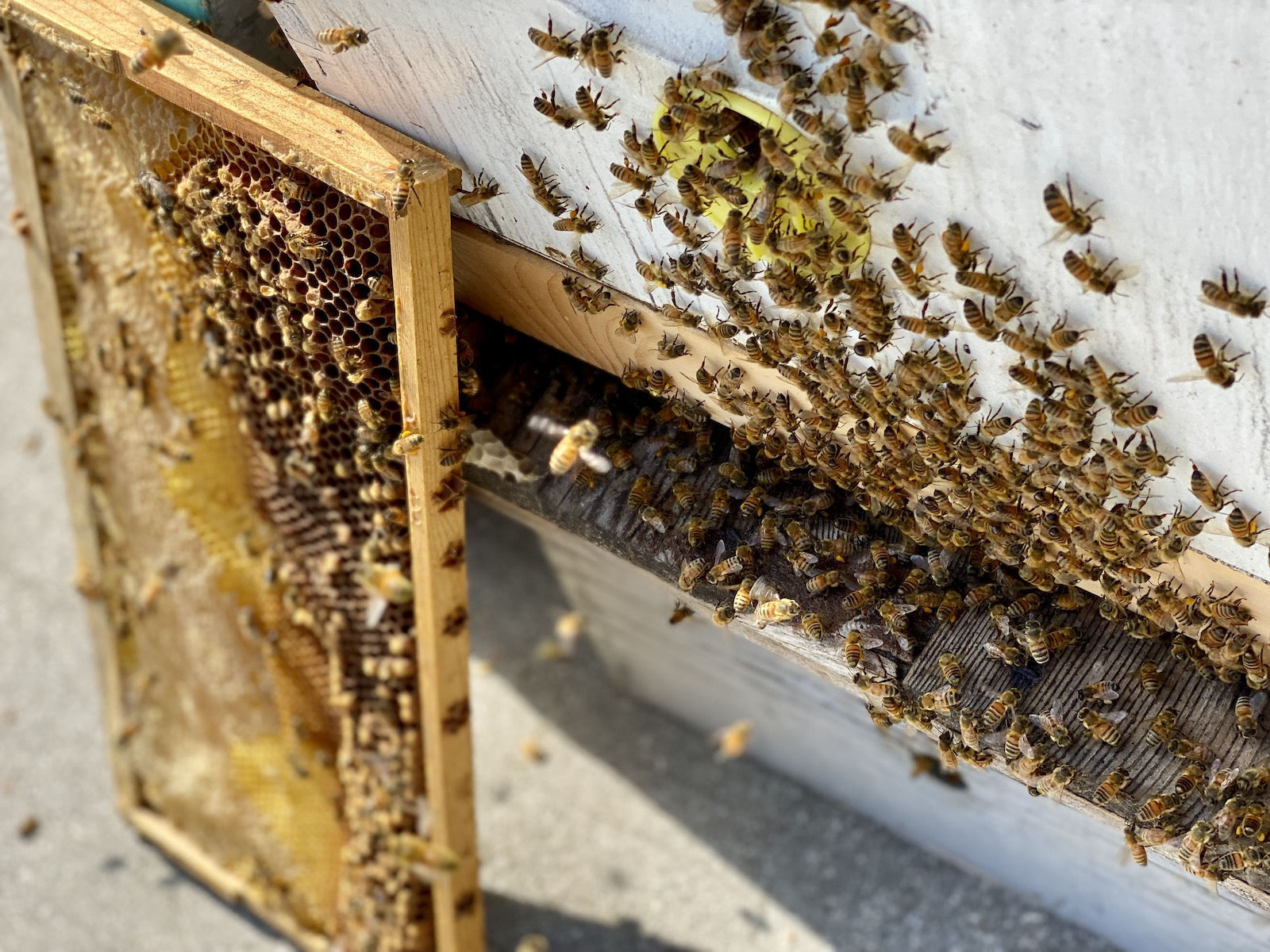Most people have no reason to venture to the top of the Hilton City Center Parking garage at 600 N. 5th St. in Downtown Milwaukee.
But beekeeper Robert McKinney of MJD Apiary is a regular visitor to the rooftop, where he maintains three active beehives seven and a half stories above the bustling city.
McKinney began raising bees years ago after he read that eating local honey (produced within 50 miles of one’s home) can have a positive impact on seasonal allergies. He gleaned further expertise by pursuing beekeeping certification through UW-Extension and continued his ongoing education through keeping and studying bees on his own.
“I don’t really even like honey,” McKinney admits shyly. “But I got really, really interested in the science behind beekeeping, and it drew me in. Thanks to ingesting local honey, I’ve also been able to build immunity to the pollen in my area, eliminating the sinus infections that plagued me for years.”
McKinney, who uses his expertise to offer services like getting folks started with urban beekeeping, relocating native bees, removing wasp colonies and educating the public about bees, maintains the hives at the Wehr Nature Center at Whitnall park, as well as numerous other locations in Milwaukee and East Troy, Wisconsin.
He also maintains three hives for Milwaukee Chophouse, giving them fresh raw honey to use at the restaurant in exchange for the rooftop space for his bees.
McKinney says the hives in the city do remarkably well, as bees will travel miles to find flowers to pollinate. Even better, the urban landscape actually provides "cleaner" flowers for the generalist pollinators, as rural areas often harbor farms that use pesticides and chemicals that aren't bee friendly.
A win for the restaurant
Hilton Executive Chef Daniel Granat says that when McKinney reached about the potential for keeping hives on the rooftop in early 2020, the culinary staff saw it as an opportunity to enhance their rooftop garden program, which has been cultivated on and off for years, but made a return in 2018 (read more on that here).
“We’ve benefited from rooftop gardens in the past," he notes, “And we had all the materials we needed to add six or eight additional boxes where we planned to grow items like tomatoes, peppers and summer squash.”
Unfortunately, when COVID-19 hit, the plans for the garden expansion were halted. But McKinney took that first summer to establish the bees in their new rooftop habitat, leaving the honey intact to nourish the bees during the colder months. After moving the bees to keep them safe during the winter, he brought the bees back to their rooftop abode again in 2021.
When Milwaukee Chophouse reopened again in August, after a 17-month hiatus, there was honey waiting to be used. So the restaurant staff got to work, deciding how to use the sweet nectar to its full advantage.
Granat says he’d been skeptical about the advantages the beehives might offer.
“I didn’t really understand how the process worked,” he admits, “and I had no idea how much honey the bees would really produce. But we’ve gotten a few gallons so far and it’s delicious. So, as it’s come in, we’ve been finding ways to put it to good use while it lasts.”
Delicious benefits
A portion of the honey is currently being used at the bar, where they’ve incorporated it into a honey syrup for The Gold Standard cocktail featuring Old Forester Bourbon and Gifford Blackberry Liqueur.
But they’ve also used the honey to enhance a Brussels sprouts side dish, which Granat says has gotten rave reviews from guests.
The dish is simple: fried Brussels sprouts dressed with a mixture of honey, lemon, salt and pepper and topped with shavings of parmesan cheese. But the complexity of the honey makes the dish exceed the simple sum of its parts.
We’ve really made it our goal to perfect our side dishes,” says Granat. “We want everything to be executed a the the highest standard possible. In this case, we took a really great recipe and just made it better by using a fresh, local product.”
Granat says they plan to continue working with McKinney to keep the hives on the rooftop. They also hope to move the rooftop gardens forward beginning in Spring of 2022.
“We’re really trying to be as local and sustainable as possible,” says Granat. “Part of it is about the advantages of turning a cement rooftop into more of a green space. But another piece of it is being able to use our own local produce in Chophouse dishes. It’s a great way to give our chefs opportunities to really get creative with different products.”
Lori is an avid cook whose accrual of condiments and spices is rivaled only by her cookbook collection. Her passion for the culinary industry was birthed while balancing A&W root beer mugs as a teenage carhop, fed by insatiable curiosity and fueled by the people whose stories entwine with each and every dish. She’s had the privilege of chronicling these tales via numerous media, including OnMilwaukee and in her book “Milwaukee Food.” Her work has garnered journalism awards from entities including the Milwaukee Press Club.
When she’s not eating, photographing food, writing or recording the FoodCrush podcast, you’ll find Lori seeking out adventures with her husband Paul, traveling, cooking, reading, learning, snuggling with her cats and looking for ways to make a difference.




